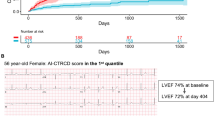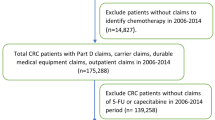Abstract
Although anti-cancer therapy-induced cardiotoxicity is known, until now it lacks a reliable risk predictive model of the subsequent cardiotoxicity in breast cancer patients receiving anthracycline therapy. An artificial intelligence (AI) with a machine learning approach has yet to be applied in cardio-oncology. Herein, we aimed to establish a predictive model for differentiating patients at a high risk of developing cardiotoxicity, including cancer therapy-related cardiac dysfunction (CTRCD) and symptomatic heart failure with reduced ejection fraction. This prospective single-center study enrolled patients with newly diagnosed breast cancer who were preparing for anthracycline therapy from 2014 to 2018. We randomized the patients into a 70%/30% split group for ML model training and testing. We used 15 variables, including clinical, chemotherapy, and echocardiographic parameters, to construct a random forest model to predict CTRCD and heart failure with a reduced ejection fraction (HFrEF) during the 3-year follow-up period (median, 30 months). Comparisons of the predictive accuracies among the random forest, logistic regression, support-vector clustering (SVC), LightGBM, K-nearest neighbor (KNN), and multilayer perceptron (MLP) models were also performed. Notably, predicting CTRCD using the MLP model showed the best accuracy compared with the logistic regression, random forest, SVC, LightGBM, and KNN models. The areas under the curves (AUC) of MLP achieved 0.66 with the sensitivity and specificity as 0.86 and 0.53, respectively. Notably, among the features, the use of trastuzumab, hypertension, and anthracycline dose were the major determinants for the development of CTRCD in the logistic regression. Similarly, MLP, logistic regression, and SVM also showed higher AUCs for predicting the development of HFrEF. We also validated the AI prediction model with an additional set of patients developing HFrEF, and MLP presented an AUC of 0.81. Collectively, an AI prediction model is promising for facilitating physicians to predict CTRCD and HFrEF in breast cancer patients receiving anthracycline therapy. Further studies are warranted to evaluate its impact in clinical practice.


Similar content being viewed by others
References
Asch FM, Mor-Avi V, Rubenson D et al (2021) Deep learning-based automated echocardiographic quantification of left ventricular ejection fraction: a point-of-care solution. Circ Cardiovasc Imaging 14(6):e012293. https://doi.org/10.1161/CIRCIMAGING.120.012293
Attia ZI, Kapa S, Lopez-Jimenez F et al (2019) Screening for cardiac contractile dysfunction using an artificial intelligence-enabled electrocardiogram. Nat Med 25(1):70–74. https://doi.org/10.1038/s41591-018-0240-2
Bonsignore A, Marwick TH, Adams SC et al (2021) Clinical, echocardiographic, and biomarker associations with impaired cardiorespiratory fitness early after HER2-targeted breast cancer therapy. JACC CardioOncol 3(5):678–691. https://doi.org/10.1016/j.jaccao.2021.08.010
Caro-Codon J, Lopez-Fernandez T, Alvarez-Ortega C et al (2020) Cardiovascular risk factors during cancer treatment. Prevalence and prognostic relevance: insights from the CARDIOTOX registry. Eur J Prev Cardiol. https://doi.org/10.1093/eurjpc/zwaa034
Chang WT, Chen PW, Lin HW, Kuo YH, Lin SH, Li YH (2022) Risks of aromatase inhibitor-related cardiotoxicity in patients with breast cancer in Asia. Cancers (Basel). https://doi.org/10.3390/cancers14030508
Chang WT, Feng YH, Kuo YH et al (2020) The impact of a multidisciplinary cardio-oncology programme on cardiovascular outcomes in Taiwan. ESC Heart Fail 7(5):2135–2139. https://doi.org/10.1002/ehf2.12840
Kadioglu O, Klauck SM, Fleischer E, Shan L, Efferth T (2021) Selection of safe artemisinin derivatives using a machine learning-based cardiotoxicity platform and in vitro and in vivo validation. Arch Toxicol 95(7):2485–2495. https://doi.org/10.1007/s00204-021-03058-4
Kim DY, Park MS, Youn JC et al (2021) Development and validation of a risk score model for predicting the cardiovascular outcomes after breast cancer therapy: the CHEMO-RADIAT score. J Am Heart Assoc 10(16):e021931. https://doi.org/10.1161/JAHA.121.021931
Kwan JM, Oikonomou EK, Henry ML, Sinusas AJ (2022) Multimodality advanced cardiovascular and molecular imaging for early detection and monitoring of cancer therapy-associated cardiotoxicity and the role of artificial intelligence and big data. Front Cardiovasc Med 9:829553. https://doi.org/10.3389/fcvm.2022.829553
Lang RM, Badano LP, Mor-Avi V et al (2015) Recommendations for cardiac chamber quantification by echocardiography in adults: an update from the American Society of Echocardiography and the European Association of Cardiovascular Imaging. J Am Soc Echocardiogr 28(1):1–39. https://doi.org/10.1016/j.echo.2014.10.003
Lyon AR, Dent S, Stanway S et al (2020) Baseline cardiovascular risk assessment in cancer patients scheduled to receive cardiotoxic cancer therapies: a position statement and new risk assessment tools from the Cardio-Oncology Study Group of the Heart Failure Association of the European Society of Cardiology in collaboration with the International Cardio-Oncology Society. Eur J Heart Fail 22(11):1945–1960. https://doi.org/10.1002/ejhf.1920
Ming C, Viassolo V, Probst-Hensch N, Dinov ID, Chappuis PO, Katapodi MC (2020) Machine learning-based lifetime breast cancer risk reclassification compared with the BOADICEA model: impact on screening recommendations. Br J Cancer 123(5):860–867. https://doi.org/10.1038/s41416-020-0937-0
Nowsheen S, Aziz K, Park JY et al (2018) Trastuzumab in female breast cancer patients with reduced left ventricular ejection fraction. J Am Heart Assoc 7(15):e008637. https://doi.org/10.1161/JAHA.118.008637
Rushton M, Johnson C, Dent S (2017) Trastuzumab-induced cardiotoxicity: testing a clinical risk score in a real-world cardio-oncology population. Curr Oncol 24(3):176–180. https://doi.org/10.3747/co.24.3349
Wang CC, Wu CK, Tsai ML et al (2019) 2019 Focused update of the guidelines of the Taiwan Society of Cardiology for the diagnosis and treatment of heart failure. Acta Cardiol Sin 35(3):244–283. https://doi.org/10.6515/ACS.201905_35(3).20190422A
Yang X, Gong Y, Waheed N et al (2019) Identifying cancer patients at risk for heart failure using machine learning methods. AMIA Annu Symp Proc 2019:933–941
Zhou Y, Hou Y, Hussain M et al (2020) Machine learning-based risk assessment for cancer therapy-related cardiac dysfunction in 4300 longitudinal oncology patients. J Am Heart Assoc 9(23):e019628. https://doi.org/10.1161/JAHA.120.019628
Funding
This study was supported by Chi-Mei Medical Center and Kaohsiung Medical University.
Author information
Authors and Affiliations
Corresponding author
Ethics declarations
Conflict of interest
None.
Additional information
Publisher's Note
Springer Nature remains neutral with regard to jurisdictional claims in published maps and institutional affiliations.
Supplementary Information
Below is the link to the electronic supplementary material.
Rights and permissions
About this article
Cite this article
Chang, WT., Liu, CF., Feng, YH. et al. An artificial intelligence approach for predicting cardiotoxicity in breast cancer patients receiving anthracycline. Arch Toxicol 96, 2731–2737 (2022). https://doi.org/10.1007/s00204-022-03341-y
Received:
Accepted:
Published:
Issue Date:
DOI: https://doi.org/10.1007/s00204-022-03341-y




